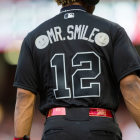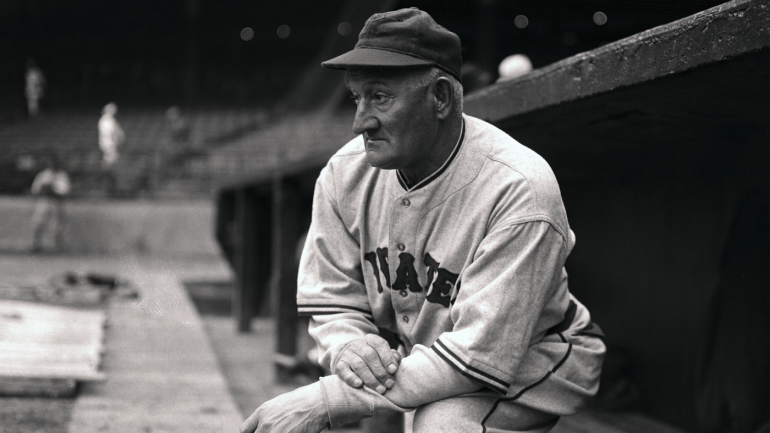
Winter approacheth, which means -- pity us all -- there is no baseball here. That means it's time for a casual walking tour of some rare Honus Wagner video footage. We hereby invite you to stare at your screen and wait for spring.
What follows is an interview with the luminous Pittsburgh shortstop, and the interview footage bookends some clips of Wagner taking his hacks at the plate and fielding his position in a practice setting.
Speaking of setting, the Sherman Grinberg Film Library, whence the forthcoming is sourced, informs us that the year is 1933 and the location is Los Angeles. Presumably, that means it's during spring training. Back in 1933, four teams -- the Cubs, the Giants, the White Sox, and Wagner's Pirates -- held spring training in California. Of those, only the Giants camped in Los Angeles proper at that time, so it's possible this is being filmed at their spring digs. Those spring digs were Wrigley Field -- a Pacific Coast League park that first opened in 1925. William K. Wrigley owned the Los Angeles Angels of the PCL, so he named their park after himself. A couple of years later, Wrigley's other team, the Chicago Cubs changed the named of their home venue from Cubs Park to Wrigley Field. Coincidentally, a major earthquake struck the Los Angeles area on March 10 of 1933, which of course would've been in reasonable proximity to the time this interview was shot.
Let's have a viewing, shall we? Our guideposts shall be the timeless praxis of the YouTube timestamp, which was the method of annotation pioneered by the Library of Ashurbanipal in the seventh century B.C., albeit in cuneiform at the time. Onward!
0:01
There's Honus Wagner -- pronounced "HONN-us," short for Johannes, nickname of "The Flying Dutchman." Wagner was the best ballplayer of the early 20th century and one of the greatest across the entire sprawl of baseball history.
Born and raised a mere few miles from Pittsburgh, where he'd author his legendary career, Wagner was a tremendous hitter and base-stealer and, in seeming defiance of his bow-legged gait and powerful "street corner mailbox" build, a slick-fielding shortstop. As the man himself tells you, he began his big league career in Louisville (appreciate his "Looey-ville" pronunciation, which may or may not be correct), which was a member franchise of the National League in its antediluvian form.
Fairly early in Wagner's big-league career, the NL underwent contraction, and the Louisville franchise was snuffed out. Barney Dreyfuss, who owned the Louisville squadron and whose name Wagner invokes early on in the video above, engineered a takeover of the Pittsburgh Pirates after the NL reduced its ranks. He brought Wagner with him, much to the eternal uplift of professional baseball in Western Pennsylvania.
Over parts of 21 major-league seasons, all with Louisville and the Pirates, Wagner batted .328/.391/.467 (151 OPS+) with 3,420 hits; 895 combined doubles and triples (!); and 723 stolen bases. His career WAR of 130.9 ranks seventh all-time among position players. Wagner's entire career was pre-integration, which means we must discount his accomplishments since he played against an artificially limited pool of competitors. In any context, though, he stands as one of the best ever to sharpen his spikes.
An outgrowth of baseball greatness is of course baseball card greatness, and in this regard Mr. Wagner scrapes the sky. The T206 Honus Wagner card produced by the American Tobacco Company from 1909 through 1911 has at various times been the most valuable sports card in the world. Here's a look, via Getty Images:
I'm tweeting this out so I can easily embed it. As you were. pic.twitter.com/HhR74gv2DR
— Dayn Perry (@daynperry) November 25, 2020
Not long after the card was first released, Wagner, for reasons not entirely clear (one explanation is that he wanted no part in promoting cigarettes to young kids), refused to permit additional runs of the card, and that left mere dozens in circulation. These days, there's one in the New York Public Library, and there's one in the Metropolitan Museum of Art. Some nuns sold another, and for a time Wayne Gretzky owned one. The Gretzky card changed hands a few times before it was eventually sold for $2.8 million to current Diamondbacks owner Ken Kendrick. The card known as the "Jumbo Wagner," so named because it was cut incorrectly during the initial run and wound up a little larger than the typical T206 card, proved to be even more valuable. It was sold in 2016 for a price of $3.12 million. Earlier this year, a Mike Trout rookie card set a new record when it was sold at auction for almost $4 million.
Anyhow, as long as we're on the subject of young Honus Wagner, please note his passing resemblance to noted catcher of footballs Rob Gronkowski:
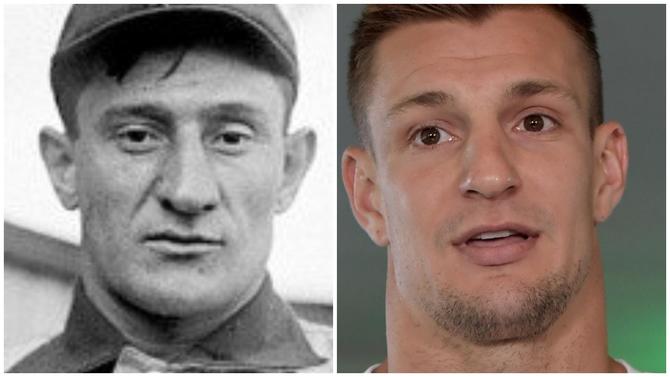
Thanks in advance for agreeing that young Honus Wagner bears a passing resemblance to catcher of footballs Rob Gronkowski.
0:16
Here we see ol' Honus taking some hacks. During his playing days, he famously used a bat that weighed more than 40 ounces, but it's not certain whether he was still swinging that caliber of lumber in his retirement. Whatever the specs, Wagner here remains fully capable of making the boys whoop and stomp and holler unifying slogans.
As noted, this video dates back to 1933, when Wagner would've been 59 years of age and retired from the majors for more than 15 years. The Great Depression hit Wagner and his post-baseball business interests hard, and Dreyfuss's son-in-law, who took control of the team following Dreyfuss' death in 1932, brought the old shortstop back in a coaching role. Wagner was tasked with molding young Arky Vaughn into a competent big leaguer. He did that and then some, as Vaughn would eventually be voted into the Hall of Fame.
By the way, if you're regarding this black and white footage and imagining the Pirates in their current colors, then in the name of all that is holy please stop doing that. They were actually red, white, and blue in those days. The black and gold didn't come along until 1948.
0:40
Here Wagner declares that contemporary pitchers relative to pitchers in his day had "harder work." That's certainly true. The thirties were very much a hitters' era, whereas Wagner toiled in the Deadball Era.
In the late nineteenth century, pitchers were finally allowed to throw overhand without restrictions, and batters were no longer able to order the pitcher to throw to a certain location within the strike zone (yeah, that was the rule until 1887). For a time, hitters were able to use flat-sided bats, and foul balls didn't count as strikes until 1893. All of those structural changes plus liberal use of the doctored ball pitches Wagner ticks off allowed Deadball Era pitchers to dominate most hitters not named Honus Wagner.
When baseball outlawed the spitball and its fellow travelers -- save for a handful of pitchers who were grandfathered in and still able to throw the pitch -- that gave hitters an edge. Babe Ruth came along and swung for the downs, which inspired others hitters to ape his approach. Call it the first Launch Angle Revolution, if you will. That further tilted the scales. Throw in evidence that the ball itself became livelier and -- the prose of a virtuoso forthcoming -- the Deadball Era was as dead as the dead ball in the Deadball Era.
Huzzah to Wagner for obliquely complimenting himself when he mentions that pitchers in his day had it easier. That, of course, means hitters like Wagner had a more onerous task than those who came along later.
0:49
Now our man Honus takes some time to grouse lovably about the state of the modern baseball glove. He mentions that in his playing days he used a glove "with nothing but the fingers on," and he tells no lies. Here's a brief excerpt from Wagner's biographical entry over at SABR:
His huge hands made it difficult to tell whether he was wearing a glove. The glove that seemed too small for his hand was made even smaller by cutting a hole in the palm and pulling out much of the stuffing. Doing so, he thought, gave him better feel and hand mobility, reasonable given the pancake-shaped glove he used.
Meaty paws? Yea and also verily: Honus Wagner had meaty paws. Anyhow, here's a Library of Congress image of the glove Wagner wore long about 1911.
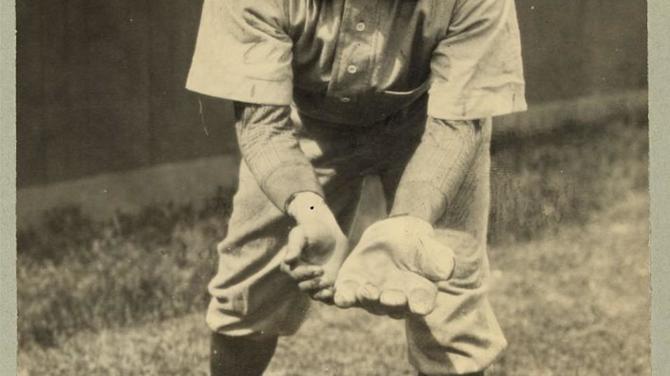
Buckskin mitten, that. Not until after Wagner's playing career was done were webbing between the fingers and the glove pocket developed.
1:07
Wagner's taking that overly padded glove and getting some reps at his old position. Let's assume for the sake of narrative momentum that the "Oh my God!" you hear exclaimed by someone just off camera is in response to Wagner's still mighty throwing arm.
1:25
No. 20 scampering back to third base so that Wagner can gamely and awkwardly pretend to coach third base during a high-leverage moment is none other than Pie Traynor. Traynor in 1933 was nearing the end of what would turn out to be a Hall of Fame career for the Pirates. He was inducted in 1948, 12 years after Wagner was a member of the Hall's inaugural class.
While viewing Traynor, we also get a glimpse of the houses beyond the left field. That plus the low-slung outfield seats in right that were visible earlier when Wagner was in the field all but confirm that this is indeed Wrigley Field near Hollywood. It's now a public playground and community mental health center.
1:45
Wagner's taking some more hacks, and at this mark we can see No. 10 in the background indulging in some dry swings. That would be Lloyd Waner, brother of Paul and owner of the very good nickname "Little Poison." The veterans' committee put Waner into the Hall in 1967.
Wagner's swing is much more level than what we see these days. His arms aren't stacked through contact, but he does have his hands going back and his lower half advances toward the pitcher. He also employs a full shoulder turn in his swing, so he's without question trying to ritually abuse the baseball.
1:52
Your notion that 59-year-old Honus could no longer lay into one? Make a pyre of thine preconceptions and commit it to those flames.
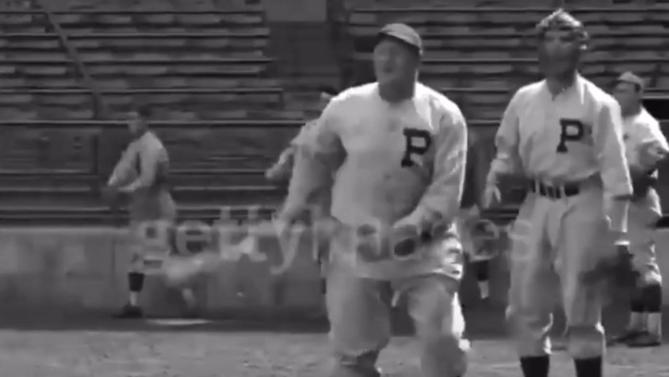
That's a cloutsman who just ripped one to or perhaps over the left field wall -- L.A.'s Wrigley Field was 330 down the line and 380 to the left field alley -- and a young catcher who saw him do it in defiance of his preexisting assumptions about what a 59-year-old can darn well do with a trusty shillelagh in his hands.
And with that our walking tour is complete. As Wagner was reputed to have once said, "There ain't much to being a ballplayer, if you're a ballplayer."
That same homespun wisdom applies to watching videos on the internet, which is what you and I have been doing instead of playing baseball in Los Angeles.




















